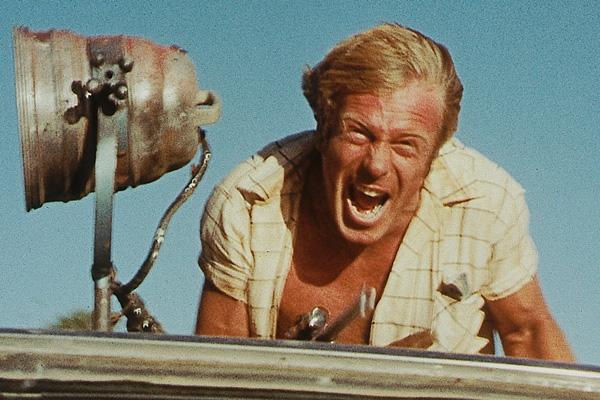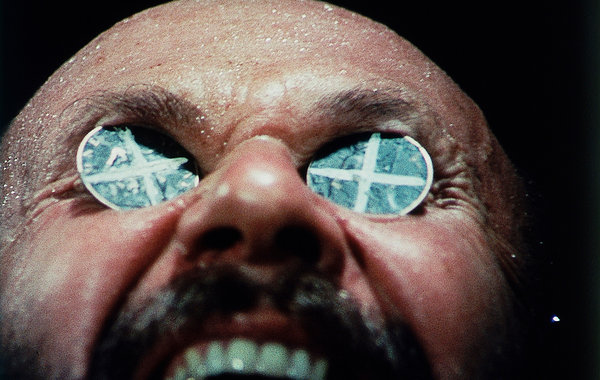by Anthony Taylor
Contributing Writer
Welcome to Apes on Film! This column exists to scratch your retro-film-in-high-definition itch. We’ll be reviewing new releases of vintage cinema and television on disc of all genres, finding gems and letting you know the skinny on what to avoid. Here at Apes on Film, our aim is to uncover the best in retro film. As we dig for artifacts, we’ll do our best not to bury our reputation. What will we find out here? Our destiny.
Apes on Film also appears on Nerd Alert News. Check them out HERE!
 EYE OF THE DEVIL – 1966
EYE OF THE DEVIL – 1966
4 out of 5 Bananas
Starring: Deborah Kerr , David Niven, Donald Pleasence, Edward Mulhare , Sharon Tate , David Hemmings
Director: J. Lee Thompson
Rated: NR
Studio: Warner Brothers Archive Collection
Region: A
BRD Release Date: October 26, 2021
Audio Formats: English: DTS-HD Master Audio 2.0 Mono (48kHz, 24-bit)
Video Codec: MPEG-4 AVC
Resolution: 1080p HD
Aspect Ratio: 1.66:1 – Original aspect ratio: 1.85:1
Run Time: 96 minutes
CLICK HERE TO ORDER
Anticipating the wave of folk horror films to come in the early 1970s, producer Martin Ransohoff’s EYE OF THE DEVIL is an entertaining amalgamation of tropes associated with several genres that readers (and viewers of the cinematic adaptations) of James George Frazer, Daphne Du Maurier, Henry James, and Dennis Wheatley will embrace, delivered by a fantastic cast.
amalgamation of tropes associated with several genres that readers (and viewers of the cinematic adaptations) of James George Frazer, Daphne Du Maurier, Henry James, and Dennis Wheatley will embrace, delivered by a fantastic cast.
David Niven portrays Philippe de Montfaucon, the Marquis de Bellenac, a wealthy French nobleman called back to his ancestral home to remedy the blight on his town’s vineyard. As in THE WICKER MAN, caretaking the wellbeing of the harvest is directly the responsibility of the local lord, and Philippe feels the heavy weight as he returns to shoulder the burden of more than a thousand years of tradition – he must make a sacrifice to ensure the bounty of the community returns. And the price is high.
 Deborah Kerr, as Philippe’s wife Catherine, follows him to Bellenac despite his urges to stay in Paris after their son Jacques has a dream in which his father needs him. Packing Jacques and sister Antoinette, they arrive at Chateau de Montfaucon (the exquisite Château de Hautefort in the Dordogne) to find local creepy archer Christian de Caray (David Hemmings) shooting doves out of the sky and his sister Odile (Sharon Tate) turning frogs into doves and hypnotizing the children. This is only a prelude to the weirdness ahead for Catherine, as she slowly peels back the mystery of her husband’s ancestral home and family history, and what’s to become of all of them.
Deborah Kerr, as Philippe’s wife Catherine, follows him to Bellenac despite his urges to stay in Paris after their son Jacques has a dream in which his father needs him. Packing Jacques and sister Antoinette, they arrive at Chateau de Montfaucon (the exquisite Château de Hautefort in the Dordogne) to find local creepy archer Christian de Caray (David Hemmings) shooting doves out of the sky and his sister Odile (Sharon Tate) turning frogs into doves and hypnotizing the children. This is only a prelude to the weirdness ahead for Catherine, as she slowly peels back the mystery of her husband’s ancestral home and family history, and what’s to become of all of them.
The troubled production – Kim Novak filmed all but a handful of scenes before being injured on set and having her part recast (and re-shot) by Kerr when she was unable to return – features outstanding performances by Tate in her first speaking film role, Hemmings just before he blew up in Michelangelo Antonioni‘s BLOW-UP, and Donald Pleasence perfecting the creepy stare he would put to good use in so many later roles. Niven and Kerr also acquit themselves well, but it’s the supporting cast that does much of the heavy lifting.
Tate was a discovery of Ransohoff’s, who was the producer of THE BEVERLY HILLBILLIES. He met Tate when she auditioned for PETTICOAT JUNCTION and he signed her to a seven-year contract on the spot. But he had bigger plans for her than a sitcom, which is clearly seen in in EYE OF THE DEVIL. She gives an amazing performance as Odile, and her commitment to her craft really shines. Hemming also creates a performance that is greater than the sum of its parts, and may be the reason the film was eventually released after Novak’s accident and the reshoots. Stuck in limbo for more than a year, his popularity after the release of BLOW-UP seems to have given the studio a reason to refocus on EYE OF THE DEVIL and complete it, finally releasing the film in 1967 in the U.S. and 1968 in the U.K.
THE DEVIL. She gives an amazing performance as Odile, and her commitment to her craft really shines. Hemming also creates a performance that is greater than the sum of its parts, and may be the reason the film was eventually released after Novak’s accident and the reshoots. Stuck in limbo for more than a year, his popularity after the release of BLOW-UP seems to have given the studio a reason to refocus on EYE OF THE DEVIL and complete it, finally releasing the film in 1967 in the U.S. and 1968 in the U.K.
Warner Archive Collection’s Blu-ray presentation of the film is visually stunning, sourced from a new 4K scan of the original film elements. The picture is crisp and secure, and Erwin Hillier ’s monochrome cinematography is a joy to behold. The audio is less effective, but it’s sourced from a half-century old mono track and performs within expectations. The only extra included on the disc is the theatrical trailer.
This film flopped in the U.S. and has stayed under the radar which is a shame. It’s well worth a watch and might just wind up becoming a new favorite. Recommended.
Anthony Taylor is not only the Minister of Science, but also Defender of the Faith. His reviews and articles have appeared in magazines such as Screem, Fangoria, Famous Monsters of Filmland, SFX, Video*WatcHDog, and more.
*Art Credit: Anthony Taylor as Dr. Zaius caricature by Richard Smith



